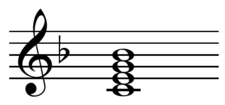
Back Jazzharmonik German Ĵazharmoniaro Esperanto Harmonie du jazz French Armonia jazz Italian Jazzharmonie Dutch

Jazz harmony is the theory and practice of how chords are used in jazz music. Jazz bears certain similarities to other practices in the tradition of Western harmony, such as many chord progressions, and the incorporation of the major and minor scales as a basis for chordal construction. In jazz, chords are often arranged vertically in major or minor thirds, although stacked fourths are also quite common.[1] Also, jazz music tends to favor certain harmonic progressions and includes the addition of tensions, intervals such as 9ths, 11ths, and 13ths to chords. Additionally, scales unique to style are used as the basis of many harmonic elements found in jazz. Jazz harmony is notable for the use of seventh chords as the basic harmonic unit more often than triads, as in classical music.[2] In the words of Robert Rawlins and Nor Eddine Bahha, "7th chords provide the building blocks of jazz harmony."[2]
The piano and guitar are the two instruments that typically provide harmony for a jazz group. Players of these instruments deal with harmony in a real-time, flowing improvisational context as a matter of course. This is one of the greatest challenges in jazz.
In a big-band context, the harmony is the basis for horn material, melodic counterpoint, and so on. The improvising soloist is expected to have a complete knowledge of the basics of harmony, as well as their own unique approach to chords and their relationship to scales. A personal style is composed of these building blocks and a rhythmic concept.
Jazz composers use harmony as a basic stylistic element as well.[3] Open, modal harmony is characteristic of the music of McCoy Tyner, whereas rapidly shifting key centers is a hallmark of the middle period of John Coltrane's writing. Horace Silver, Clare Fischer, Dave Brubeck, and Bill Evans are pianists whose compositions are more typical of the chord-rich style associated with pianist-composers. Joe Henderson, Woody Shaw, Wayne Shorter and Benny Golson are non-pianists who also have a strong sense of the role of harmony in compositional structure and mood. These composers (including also Dizzy Gillespie and Charles Mingus, who recorded infrequently as pianists) have musicianship grounded in chords at the piano, even though they are not performing keyboardists.
The authentic cadence (V-I) is the most important one in both classical and jazz harmony, though in jazz it more often follows a ii or II chord serving as predominant. To cite Rawlins and Bahha, as above: "The ii-V-I [progression] provides the cornerstone of jazz harmony"[2]
The ii-V-I (ⓘ) may appear differently in major or minor keys, m7-dom-maj7 or m7♭5-dom♭9-minor.[4]
Other central features of jazz harmony are diatonic and non-diatonic reharmonizations, the addition of the V7(sus4) chord as a dominant and non-dominant functioning chord, major/minor interchange, blues harmony, secondary dominants, extended dominants, deceptive resolution, related ii-V7 chords, direct modulations, the use of contrafacts, common chord modulations, and dominant chord modulations using ii-V progressions.
Bebop or "straight-ahead" jazz, in which only certain of all possible extensions and alterations are used, is distinguished from free, avant-garde, or post-bop jazz harmony.[2]
- ^ Cite error: The named reference
Stacking Thirdswas invoked but never defined (see the help page). - ^ a b c d Cite error: The named reference
Rawlins 2005was invoked but never defined (see the help page). - ^ "Jazz Theory & Pop Music Harmony : Learning Improvisation". 19 April 2012. Retrieved 2022-01-25.
- ^ Cite error: The named reference
Spitzer 2001was invoked but never defined (see the help page).
© MMXXIII Rich X Search. We shall prevail. All rights reserved. Rich X Search